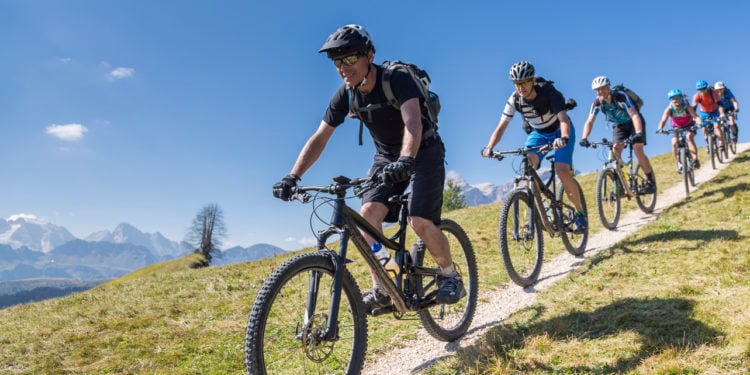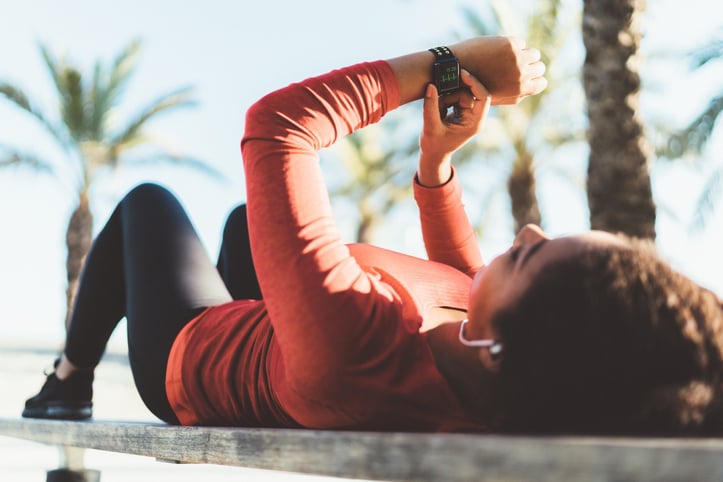Here’s how to help your clients enjoy every pedal stroke.
Steven Capraio, NASM-CPT, SFS, never actually thought much about riding a bicycle—literally or figuratively. “I played baseball and softball and trained with weights,” he says. “I had heard about the Tour de France, but I thought it was just a bunch of guys riding around the countryside, so I never gave it much thought.” Then one day he walked into his neighborhood bike shop. “They had the Tour on the TV and I saw they had these amazing bikes and were racing across this incredible terrain. I looked around the shop and saw all these shoes and clothes and equipment, and I decided to find out what cycling was all about.”
That day Capraio discovered what more than 39 million people in the United States already know: Cycling is an excellent form of exercise that’s also a whole lot of fun. “You can do it in a group or you can do it on your own. Anybody can ride, no matter their age,” says Capraio. That may be why market-research studies consistently list cycling as one of the top 10 outdoor recreational activities in the U.S. “I bought my first bike that day and I’ve been hooked ever since. The more you put into it, the more you improve. I’ve encouraged a lot of men and women at the gym to get into the sport.”
Do you have clients who have a new interest in cycling (on its own or as part of a triathlon) or who are looking to take their cycling to the next level? Here’s what you need to know to improve their form, boost their performance, and meet their fitness goals.
Benefits of the Bike
There’s a reason the stationary bike is one of the most commonly used tools in rehab: Even if walking is difficult, you can usually still pedal. For that reason, cycling can be a great addition to nearly any client’s exercise routine, regardless of his or her fitness level, says Jim Cooper, NASM-CPT, PES, of Signature Cycles in New York City. “Cycling is a low-impact aerobic exercise, so it can strengthen your cardiovascular system and improve your metabolic rate in a way that’s easier on the body than other aerobic activities, like running. I personally like that you can cover a lot of miles and see different things.”
Dara Marks-Marino, NASM-CPT, a USA Cycling–certified cycling and triathlon coach in Flagstaff, Ariz., echoes those sentiments. “Cycling offers lots of unique benefits—fresh air and sunshine, shared time with friends, and, of course, extraordinarily strong and sexy legs,” she says. And Elizabeth Seifert, a Web designer and IT specialist in Woodstock, Ga., mentions yet another benefit: feeling like a kid again.
“I started riding just before my 42nd birthday,” Elizabeth says. “I got a cheap hybrid bike and started riding on the road. I was hooked! I was just so happy to be outside, making new friends and enjoying the scenery. It never felt like exercise. It doesn’t matter who you are—I’ve met and ridden with folks in their 60s and 70s and know of folks in their 80s who still ride—you can find enjoyment on two wheels.”
Your Best Cycling Partner
If a client shows interest in cycling, your first step is to get them the help they need for the best possible experience. Unless you’re well versed in cycling, that means connecting with a well-respected local bike shop.
A basic bike check at the shop usually means an inspection of the tires and brakes and the working condition of the bike, says Capraio. If they’re in the market for a new bike, the shop will help them find the right bike for how (racing or for fitness) and where they want to ride (roads, trails, or both).
“Most people will be shocked by how many different types of bikes there are and how radically different they ride,” says Capraio. “You might be tempted by a superlight racing bike but not realize that they are so light and twitchy they can actually be harder to ride than something a little heavier, which is more stable,” he explains.
The most important cycling-related purchase your client can make, after a helmet (see below)? A professional bike fitting (which you can learn about at the local shop)—because a bike that doesn’t fit is uncomfortable and inefficient. “Improper fit can create overuse issues and muscular imbalances,” says Cooper. “Most new riders leave cycling because of pain from a poorly fitted bike.”
Finally, there’s the saddle (or bike seat). Your glutes might feel tender on the first few rides, but long-term soreness is the sign of a bad match. The bike shop can help with options there, too.
Time to Ride!
Most trainers won’t be out on the road or trail for one-on-one sessions, but there are many ways you can tailor a client’s cycling workout to benefit their time on the bike.
- Integrate cycling into your plans. “Cycling makes your body strong, but you also need to make your body strong for cycling,” says Marks-Marino. “Clients should still be doing strength training.” NASM’s Optimum Performance Training™ (OPT™) model is a great fit, as it can build full-body balance while boosting strength for cycling.
- Encourage progress. How often and how long your clients ride depends on their experience and goals. Encourage new riders to aim for 60 to 90 minutes (about 15 to 25 miles, depending on their speed and the terrain) about three times a week. Experienced riders should increase their total volume of riding by about 10% each week, until they reach their goal distance or the volume they’d like to ride.
- Help them get faster. Structured intervals can boost fitness gains and overall speed, says Cooper. “Like all training, cycling improvement is based on the body adapting to overload,” he says. “For cyclists, that means the lactate threshold interval work needs to be hard enough to lead to adaptation.”
Cooper recommends basic intervals a couple of times a week. “I start with five minutes on and five minutes recovery, repeated three times. Then you can progress or regress depending on what the rider needs.” You can also vary the resistance, effort, and cadence, notes Cooper. For instance, you can have a rider do one minute of fast pedaling at a designated effort level; then have them shift into a harder gear and do one minute of slower pedaling at the same level of effort. “I recommend using a heart-rate monitor [“Gear Up,” below],” Cooper says, “to really focus on training.”
- Keep it fun—and social. The local bike shop that’s your partner for bike checks and fitting likely offers group rides that make cycling a social experience. At the very least, the shop can offer suggestions on routes to vary mileage, intensity, and scenery.
“I tell people they can even make a game out of it,” says Capraio. “I live on a golf course, so I take advantage of the off times to ride the cart path, which is eight miles long, when the golfers aren’t out there. I started racing myself, trying to improve my time on that loop. I feel like a stock car racer. It’s awesome.”
GEAR UP
The right equipment and accessories can make every ride a joy ride. Here are three essentials (and one extra) to help your clients go the extra mile.
• Helmet A must-have. It should fit snug, with the front edge sitting just above the eyebrows. Straps should be tight enough that a finger can slide between chin and strap, but not more.
• Bike shorts Built-in padding cushions tender tissues. Surprise note: They aren’t meant to be worn with underwear.
• Clipless pedals and shoes Experienced riders use pedals that attach to cleats on the bottom of special stiff-soled cycling shoes, so they can generate more power. Clipping in and out smoothly takes practice, though.
• Computers and GPS Many modern bike computers incorporate GPS to tell you how far and fast you’ve gone, highlight your route and elevation gained, and monitor a host of other information, including heart rate (if you have a heart-rate-monitor chest strap). You can download the data into various computer programs to track your progress and set goals.
TRY THIS
A cycling camp can take a client’s riding to the next level. Here are some of the top mountain-biking destinations offering fully supported rides and instruction.
Whistler, British Columbia. A hotbed of mountain biking and home of the Trek Dirt Series, one of the world’s premier skills camps (dirtseries.com).
Vermont. Grab a few friends and set up a tour through Vermont Adventure Tours (vermontadventuretours.com).
Utah. Mountain bike vacation outfitter Western Spirit Cycling offers beginner-friendly trips through the jaw-dropping red rock terrain of Canyonlands National Park.
BOOST YOUR SKILLS
Good Form for Better Rides
Cyclists enjoy a challenge, whether they’re road riders, mountain bikers, or triathletes. But long hours of training can lead to imbalances and overuse injuries. NASM’s Corrective Exercise Specialist (CES), Performance Enhancement Specialist (PES) and strength and conditioning coach programs can help with both. With these skills, you’ll be able to help the cyclists you work with improve performance, overcome injuries, and avoid potential overuse injuries in the future.
MEET OUR EXPERTS
Dara Marks-Marino, NASM-CPT, runs mountain bike clinics through her company, The Mindful Athlete (themindfulathlete.net).
Steven Capraio, NASM-CPT, SFS, picked up cycling after decades of playing stick and ball sports, and he hasn’t looked back.
Jim Cooper, NASM-CPT, PES, works with clients through Signature Cycles, a custom bike studio in New York City that’s focused on fitting.
Author: Selene Yeager
<rev4.18>

















